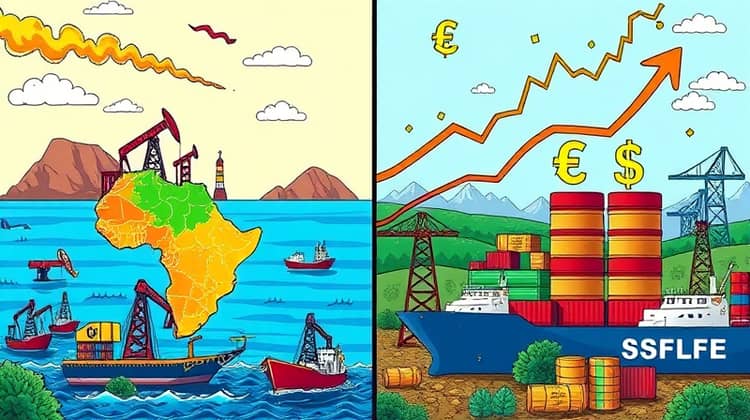Understanding how oil prices influence global economic stability is crucial for comprehending the interconnected nature of today’s financial systems.
Oil prices affect not just the cost of fuel but have widespread implications that ripple out across economies, affecting everything from inflation to employment rates.
In this article, we will explore how oil prices fluctuate and the various factors influencing these changes, including global demand shifts, geopolitical tensions, and technological advancements.
Additionally, we will delve into the impact of oil price shocks and explore the vulnerabilities of oil-dependent economies.
Finally, we will look at how these economic dynamics interplay to shape global economic stability, providing a comprehensive understanding of the intricate relationship between oil prices and the balanced functioning of the world economy.
The Basics: Understanding Oil Prices

To begin with, oil prices are determined by the supply and demand dynamics in the global market. Variations in production levels, geopolitical events, and changes in consumer demand can lead to significant price fluctuations. Understanding these fundamentals helps shed light on the complexities underlying oil pricing.
The Organization of the Petroleum Exporting Countries (OPEC) plays a pivotal role in influencing oil prices by regulating production levels among its member countries.
The decisions made by OPEC have the power to either stabilize prices or trigger volatility based on collective production output.
Additionally, external factors such as economic sanctions, natural disasters affecting oil production, and advancements in alternative energy sources also contribute to the unpredictability of oil prices. This volatility has direct implications not only on the energy market but also on global economic health.
The Economic Cycle and Oil Prices

Oil prices are intricately linked to the economic cycle—periods of expansion and recession typically correlate with fluctuations in oil prices. During economic growth, demand for oil surges, resulting in price increases. Conversely, during slowdowns, demand diminishes, leading to falling prices.
- Demand for oil rises during economic booms, increasing prices.
- Recessions often see a fall in oil prices due to decreased consumption.
- Oil price changes can precede recessions, serving as an economic indicator.
Oil Price Shocks and Their Impact

Oil price shocks can drastically affect economies around the globe. When prices surge, consumer spending can be diverted from discretionary purchases to cover higher fuel costs, which may slow economic growth.
Historically, significant oil price hikes have led to stagflation—where economic growth stalls while inflation rises. This phenomenon makes it difficult for central banks to formulate effective monetary policy responses aimed to stabilize the economy.
Conversely, sudden drops in oil prices can lead to deflationary pressures, impacting oil-producing nations while benefiting oil-importing countries. The overall economic landscape shifts depending on whether oil prices are rising or falling, illustrating the sensitivity of global markets to oil price volatility.
Ultimately, these price shocks can lead to uncertainty in financial markets, affecting investments and economic confidence on a global scale.
Oil-Dependent Economies

Countries that rely heavily on oil production for their revenues are particularly vulnerable to fluctuations in oil prices. For these nations, a drop in oil prices can create budget deficits and economic instability, often leading to cuts in public spending.
Furthermore, many oil-dependent states experience high unemployment rates when oil prices fall, as the production-dependent sectors face cutbacks. The social and political ramifications can be severe, often leading to unrest or governmental changes.
Diversifying their economies has become crucial for these nations, helping to mitigate the adverse effects of oil price volatility and ensuring long-term economic resilience.
- Vulnerabilities of oil-dependent economies can lead to social unrest.
- Budget deficits are common in oil-reliant nations during price drops.
- Economic diversification is essential for stability.
Inflation and Oil Prices

Oil prices are a significant driver of inflation, as they impact transportation costs and manufacturing expenses. When oil prices rise, production costs increase, leading businesses to pass these costs onto consumers.
This transmission of higher costs through the economy can create a cycle of inflation, resulting in increased prices for goods and services as businesses attempt to maintain profit margins.
Exchange Rates and Oil Prices

The relationship between oil prices and exchange rates is critical, especially for countries that import or export crude oil. A high oil price generally strengthens the currency of oil-exporting countries while weakening that of oil-importing nations.
Conversely, when oil prices plummet, importers may experience currency appreciation, impacting their trade balances and overall economic stability.
Geopolitical Tensions and Oil Prices

Geopolitical tensions can lead to significant fluctuations in oil prices, often causing them to spike dramatically during conflicts or diplomatic crises. The fear of supply disruptions can lead to panic buying and increased oil prices, irrespective of market fundamentals.
Regions such as the Middle East, where much of the world's oil reserves are located, are particularly sensitive to geopolitical events, affecting global supply chains and energy security.
As a result, countries must navigate these tensions carefully to ensure both stable energy supplies and economic security.
Technological Advancements and Oil Prices

Technological advancements, particularly in renewable energy and extraction processes, are changing the landscape of oil markets. Innovations in fracking and horizontal drilling have created new oil supplies that can shift the supply-demand balance.
Moreover, the transition toward sustainable energy sources impacts long-term demand for oil, thereby influencing pricing structures in unpredictable ways.
- Increased efficiency in extraction technologies can lower production costs.
- The rise of renewable energy can decrease demand for fossil fuels long-term.
- Advancements in electric vehicles can reduce oil consumption significantly.
Conclusion

The influence of oil prices on global economic stability is undeniable. Fluctuations in oil prices can create cascading effects across various economic sectors, underlining the significance of energy markets in global finance.
As economies continue to evolve with technological advancements and shifting geopolitical landscapes, understanding the dynamics of oil prices will remain crucial for policymakers and businesses alike.










